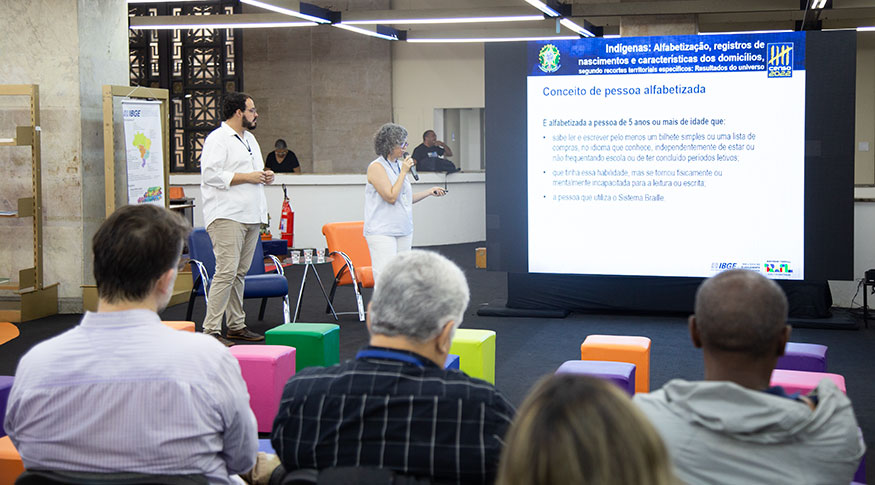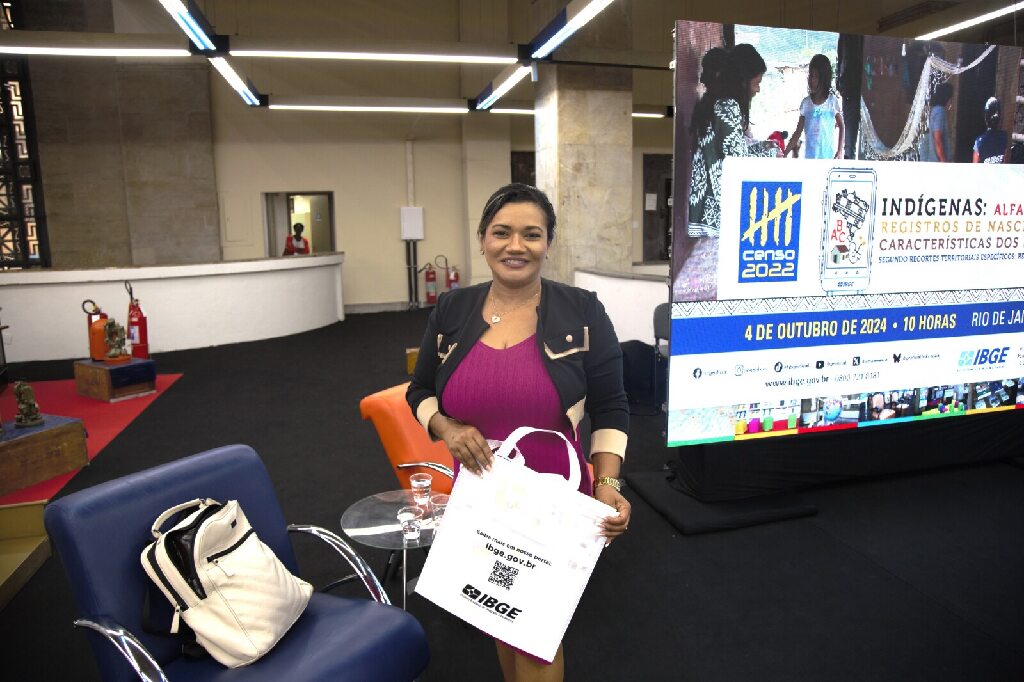Casa Brasil IBGE
2022 Census: IBGE releases information on literacy, birth records and characteristics of housing units of Indigenous populations at Casa Brasil IBGE
October 04, 2024 03h36 PM | Last Updated: October 09, 2024 10h22 PM

The Brazilian Institute of Geography and Statistics (IBGE) released today, 4, data relative to the “2022 Population Census - Indigenous Populations: Literacy, birth records and characteristics of housing units, by specific territorial areas: Population results” at Casa Brasil IBGE, on the ground floor of Palácio da Fazenda, located downtown Rio de Janeiro (RJ). The event was attended by IBGE civil servants, authorities and members of civil society, and was streamed live on Digital IBGE. This was the second release of the 2022 Census at Casa Brasil IBGE, a space for memory and technology, which gathers different areas of the Institute and their activities in almost 90 years of existence.
The supervisor for relationship with the press at the IBGE’s Social Coordination Communication (CCS), Marcelo Benedicto, conducted the presentation, which was attended by the director of Surveys, Elizabeth Hypólito, the director of Geosciences, Ivone Lopes Batista, the technical coordinator for the Population Census, Gustavo Junger, the manager for Traditional Territories and Protected Areas within the Coordination of Territorial Structures of the Directorate of Geosciences (DGC), Fernando Damasco, and of the technician in charge for the IBGE Technical Project on Traditional Peoples and Communities, Marta Antunes.
The IBGE also received authorities such as the regional superintendent for Administration of the Ministry of Management and Innovation (MGI) in Rio de Janeiro, Ângela Carnaval, the head of the Administrative Management Division of Ministerial Office, Leandro Carvalho, and a representative of the Secretariat of Education in the state of Roraima, Eliane de Sousa.
Elizabeth Hypólito, IBGE’s director of Surveys, mentioned that “this release is the result of extensive work to expand the Population Census and have information about the Indigenous population, a work that innovates in the capture of information about this population, thus fulfilling the Institute’s mission of portraying Brazil with necessary information for the knowledge of reality and the exercise of citizenship.”

The director of Geosciences, Ivone Lopes Batista, thanked all the team from the Institute, who contributed to the collection of data throughout the Population Census, such as State Superintendencies. She also remarked that “these data evidence an improvement in the Indigenous population and a continuation of inequality compared to the rest of the population.”

Gustavo Junger, technical coordinator for the Population Census, praised the work of the IBGE team to release the 2022 Census results. “This release makes us proud; we thank thousands of enumerators, Survey and Mapping agents and the service of each superintendency. The demand about the Indigenous population has been observed for decades and today, for the second time, we present information about literacy, number of births and characteristics of housing units of this population.”

The regional superintendent for Administration of the Ministry of Management and Innovation (MGI) in Rio de Janeiro, commented on the partnership between the IBGE and the Ministry and the places to visit at Palácio da Fazenda. “It is always good to receive you. I invite you all to visit our museum, also our library and be in touch with the beautiful view in this building. The IBGE formed this collection with Casa Brasil and it is rewarding for the Institute to have some space here.”
5998: Ângela Carnaval, regional superintendent for Administration of the Ministry of Management and Innovation (MGI) in Rio de Janeiro, commented on the partnership between the IBGE and the Ministry and the places to visit at Palácio da Fazenda - Photo: Marcio Costa/IBGE News Agency
Data on literacy, birth records and characteristics of housing units of indigenous peoples

The technical team formed by Marta Antunes and Fernando Damasco presented the data on literacy, birth records and characteristics of housing units of indigenous peoples in the 2022 Population Census.
The presentation was split into three parts, the first one about illiteracy indexes of this population. The illiteracy rate of indigenous populations, which was 23.4% in 2010, fell to 15.0% in 2022; however, it corresponds to more than twice the national rate, which was 9.6% and fell to 7%. In each age group, the same trend is observed in relation to the national population. That shows more access to opportunities in education for younger generations than for older ones, among indigenous people, due to the increase of access to education in recent years.” Marta Antunes highlighted.
In the second part, the technicians showed data relative to birth records of indigenous people, with an increase from 67.3% in 2010 to 89.1% in 2022. Despite the significant increase, it is still beyond the total population (99.2%). Among children aged up to 5, 94.0% were registered, either in a registry office or Administrative Record of Indigenous Birth (RANI). “A child without a document faces difficulties in the access to a number of fundamental rights,” says Fernando Damasco, Manager for Traditional Territories and Protected Areas of the Coordination of Territorial Structures, of the Directorate of Geosciences (DGC).
Finally, they also presented to the attendees information on characteristics of housing units. A total of 630,428 private housing units have at least one indigenous resident, inside or outside indigenous lands, as if they lived in dwellings without walls or in huts. “In 2022, approximately 69.1% of the Indigenous peoples living in permanent private housing units faced at least some precarious condition or lack of basic sanitation, related to water supply, sewage disposal or garbage disposal.”
The technical team also presented ways for the public to access complete data about this and other surveys, such as SIDRA (IBGE System of Automatic Retrieval) and PGI (Interactive Geographic Platform). “We can use as interactive map and combine data such as the number of collective housing units, for example, retirement home by state and ageing index (ration) by Federation Unit (FU),”, Marta Antunes explained.
Population Census data reach the public in general

Eliane de Sousa is the manager for Technology in the Qualification Center for Education Professionals of Roraima and a representative of the Secretariat of Education of the state of Roraima and joined the event to monitor data relative to the indigenous population in more than one release. “What stands out is the reference to literacy data; we work with a program named Criança Alfabetizada (Literate Child), inside the indigenous community. Our Qualification Center deals directly with these populations and, with these data, we can identify where the literacy problems stands and how we can offer our contribution,” Eliane de Sousa said.


















